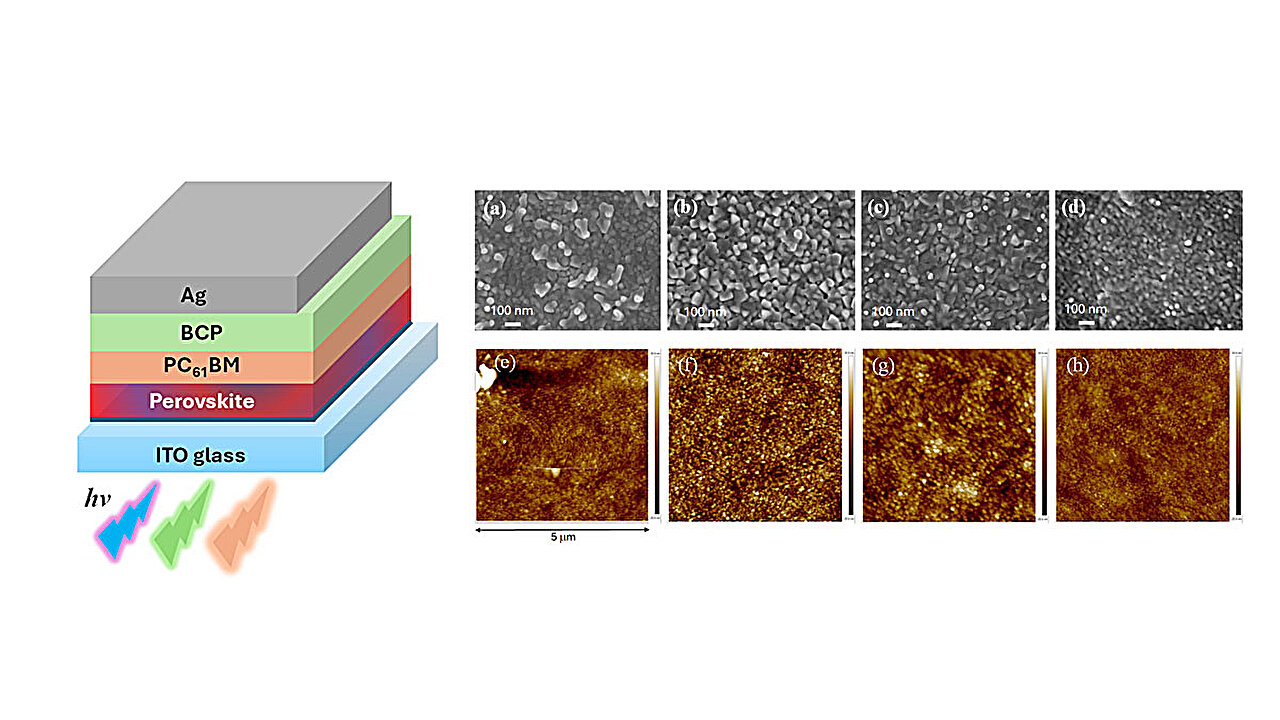
The device layers of the perovskite solar cell, and the surface textures of the perovskite layers prepared under different conditions. Credit: HSU et al.
When you think of solar panels, you usually picture giant cells mouted to face the sun. But what if “solar” cells could be charged using fluorescent lights?
Perovskite Solar Cells (PESCs) have emerged as a lower -Cost, Higher-Efficiency Alternative to Traditional Silicon Solar Cells du to their Material Structure and Physical Flexibility. Their Large Power Conversion Efficiency Rate (PCE), which is the Amount of Energy Created from the Amount of Energy Hitting The Cell, Makes Pescs Well Suited to Converting Lower Energy.
In Apl energyResearchers from National Yang Ming Chiao Tung University in Taiwan Created Perovskite Solar Cells that Effectively Convert Indoor Lighting into Electrical Power.
“The most common solar cells in the market are silicon-based solar panels,” said Author Fang-Chung Chen. “However, pescs can be made thin, lightweight, flexible, and even semi-transparent, whereas silicon panels are right and heavy, which limits their use to flat, Durable Surfaces.”
Previous Research has shown that pescs can reach power conversion efficiencies Comparable to Silicon Solar Cells, but with the Bonus of Being Able to Work Indoors. These pescs can be used to charge devices like remote controls, wearable devices, or trackers that can be connected to the internet.
To make a solar cell almost to convert indoor light to energy, the reserchers needed to tune the bandgap of the composition of the perovskite.
Bandgaps descibe the minimum energy Necessary for Electrons to Jump to Higher Energy Levels, and different bandgaps can absorb different light wavelengts.
By adjusting the ratios of the molecules in the solutions used to make the perovskite layers of the solar cells, the resarchers was abled to achieve an optimal bandgap for absorbing indoor. This Bandgap Adjustment is not something that can be done in silicon solar cells.
“The indoor efficiency of pescs is Higher, meaning that the photovoltaic products can be more suitable for versatil user Scenarios, Including Clouding Outdy Outdy, Indoor, and Other Dim-Light ENVIRONMENT ENVORONMENT ENVORONMENTS Said Chen.
“Tuning the bandgap, unfortunately, Accompanies a negative effect: it brings defects in the perovskite layers,” said chen. “To compensate for the loss in efficiency, we propose one method for fixing the defects.”
Under the one Standard Sun Illumination (Close to 12,000 Lux), The Team’s perovskite cells achieved a pce of 12.7%, which, compared to some of the highest pse of the highest pse of ali Silicon Solicon Solls of 26%, ISN’T MUCH. However, the pescs displayed an impressive pse of 38.7% under 2,000 lux, which is a fruction of the light that come from the sun on a Sunny day and is a similar brightness level toay in.
To chen’s surprise, their strategy for passivating the perovskite layer, which makes it lesss susceptible to corrosion, also improved the overall pesc’s stability.
“In the beginning, we only expected our approach would improve the device efficiency,” said chen. “Being the poor reliability of pescs is a large challenge for their adoption, we hope our proposed method can Pave the way to the way toward the Commercialization of Perovskite Solar Panels.”
More information:
Chelating agent-based defect passivation for enhanced indoor performance of wide-bandgap perovskite solar cells, Apl energy (2025). Doi: 10.1063/5.0260714
Citation: Modified perovskite solar cells harvest energy from indoor fluorescent lighting (2025, june 24) retrieved 5 july 2025 from https://techxplore.com/news/2025-06- Peerovskite- Solar- Cells- HARVEST- Energy.html
This document is Subject to copyright. Apart from any Fair Dealing for the purpose of private study or research, no part may be reproduced without the written permission. The content is provided for information purposes only.



